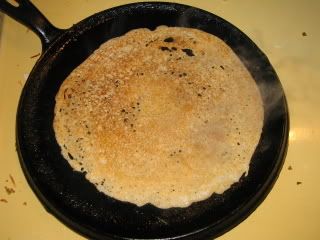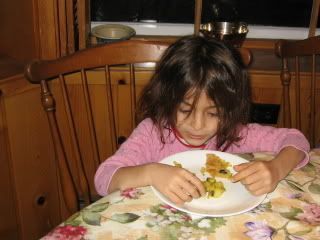Hi all,
Today I made Dosas in a Non-Traditional way. If anyone is not familiar with these: They could be called Indian Crepes made with Rice.

The traditional way of making these is
(1) Soak rice and Urad dal overnight. (Urad Dal is a kind of split bean which can be found in an Indian Grocery Store).
(2) Grind these up in the morning (you can do this in a Food Processor if you don't want to go absolute traditional). This will give a nice paste.
(3) Now you let this get sour (kinda like sourdough). Put in the sun all day long, if the outside is warm), or put in some other warm corner of the house. Hopefully, by the end of the day you will have the batter sour and bubbling. If not wait longer :-(
(4) Add salt to it, and adjust the thickness of the paste. (I would say the thickness is in between that of a pancake and crepe batter).
(5) stir the batter briskly.
Then you cook them up on a hot skillet, in a slightly different manner than crepes.
(1) Grease the skillet with Ghee or any other cooking oil.
(2) Depending on how big your skillet is, pour some paste on the in the center (a metal measuring cup can be convinient), and with the flat base of the measuring cup start spreading it thin on the skillet. It takes some practice to get this right.
(3) The thinner the better.
(Though if you want you could probably make it thinner and cook it like crepes, I haven't tried that!)
(4) When it seems to be really crunchy and golden brown on the bottom flip it over and cook slightly on the other side.
Filling
These can be filled with a variety of filling, but the most common is a spicy potato mixture spiced with (of cource) Indian spices.
(If anyone interested I can post that.)
/****************************************************************************/
OK, so what does it have to do with the SOURDOUGH us people talk about here on the Fresh Loaf????
So here it goes. I had some brown rice flour sitting on my shelf not getting used.... Also I didn't make any breads this week and since I needed to feed my starter, I was going to have some extra starter.
So here goes my modified SourDough Dosa Recipe:
(All the ingredient amounts are in approximation, so use your intuation).... ;)
Ingredients
About 1 1/2 cups stiff wholewheat sourdough starter. ( you could probably use less )
2 1/2 cups water. (but maybe less like 2 cups, as you can always add more water later to get the consistence right).
4 cups (brown) rice flour. (you could probably use white if you want)
salt (about 1 tbsp not too sure, you'll have to go by feel here)
Method
(1) break the starter up into smaller pieces (10-15 pieces).
(2) Add water and with your hands dissolve all the sourdough chunks in the water until it is a big slurry.
(3) Now, start adding rice flour to this. and mix up with a fork making sure all the clumps of flour get dissolved nicely.
(4) Let it sit in a warm place, for as long as it takes :)
(5) Add salt before cooking them. Also adjust the thickness of the paste. It should be thinner than pancake but thicker than crepes' batter.
(6) stir the batter briskly.


(7) Cook them according to the directions above in the traditional method.


(8) Fill them up with your favourite filling or keep them plain.

(9) Eat them hot and crispy right off the skillet or they'll loose the crispyness fast.



NOTE:
(I started it late morning yesterday, but because of using so much starter it was progressing pretty fast. I actually started with 3 cups of rice flour, and about by night it was super bubbly and I didn't want to cook them last night, so I added 1/2 cup more flour and refigerated it. I took it out of the fridge about noon today and since it was quite bubbly again, I added 1/2 cup more flour and cooked them after 1/2 an hour).
(We had these for lunch as well as for dinner :D, yum) They had a nice sour taste which stays in your mouth a long time after you eat them, but not super sour when actually eating them. Also I think, the potatoes balanced them out as well.
These are accompanied by coconut chutney and Sambhar (which is like a thin soupish dal/soup made of split beans).